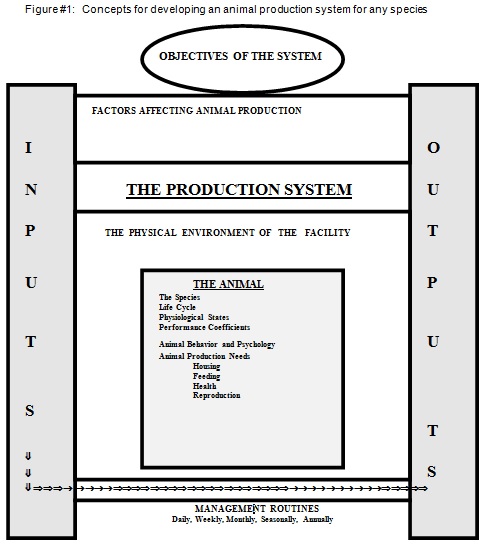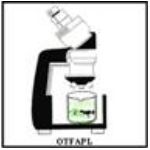Topics Covered in this Section
14.7 The Role of Housing and Equipment under Intensive Systems of Production
14.8 Approaches at Non-Domestic Wild Animal Production Intensification
14.9 Concepts in Developing Intensive Animal Species Production Modeling
14.10 Some Rationale behind Intensive / Semi Intensive Wildlife Production/Farming
AGLS 6502 Lecture 14.2 - Wild Animal Production Intensification
This involves the bringing together of many animals in a single location or in close proximity to each other with consequent problems.
Features of intensification:
- use of limited land
- high animal to land ratio
- high levels of technical and managerial inputs are required
- variable quantities of capital outlays are required
- labor demanding
- expected product output required.
The Implications of Intensification on Production
- Animals have to be fed and watered with timely waste removal.
- Preventive techniques have to be instituted to avoid introduction and rapid spread of diseases.
- Animals’ social behavior need to be considered and provisions made for the animal social needs to be met.
- The design of the housing plays a key role in facilitating all of the above.
14.7 The Role of Housing and Equipment under Intensive Systems of Production
- To protect the animal from the environment and predators.
- To ensure the timely and controlled supply of feed nutrients and water.
- To exclude disease causing organisms and to eliminate or minimise the possibility of and spread of diseases.
- To protect the animals from trauma.
- To protect man and to facilitate the ease of handling of animals through:
- special features and considerations for handling , restraint and treatment of animals ,
- having the animals arranged into different physiological states.
- To facilitate timely and efficient removal of waste.
- To enable the grouping of animals into manageable units which could make the easy observation of animals individually,
- To enable the easy handling of animals for either product collection (e.g. eggs) and or the sorting of animals for marketing,
- To modify the environment to alleviate any stresses which would be constraints to productivity,
- To provide specialist type of equipment to facilitate slaughter and processing.
Key elements of livestock housing under intensive conditions
1] Water Supply
- Source; availability; method of transport [gravity, public supply, pumped]
2] Power Supply
- Public; Generator; Solar power; Wind; Water; Biogas
3] Enclosure, Housing and or handling requirements based on species needs.
14.8 Approaches at Non-Domestic Wild Animal Production Intensification
Earlier the concepts for designing an animal production system were outlined. Figure 1 presents this graphically. We are sometimes asked to design a system without all the system’s components being known. What we should then try to do is to gather all that is known about a more popular related species within the same family as follows:
- the nature of the digestive system [ Digestion and Feeding ]
- the nature of the habitat and nesting sites of the species under consideration [ Housing and Environment ]
- the reproductive system and habits [ Reproduction and Breeding ]
- the social habits
- diseases which affect the species [ Disease Prevention and Control ]
A further consideration.....
- The objectives of the production system must be clearly established from the start to identify which physiological states would have to included in the model.
- The source of the animals for the production system to be established needs to be identified:
- Wild Caught Captive Breeders
- Wild caught juveniles for growth
- Management of all physiological states
- Other?
14.9 Concepts in Developing Intensive Animal Species Production Modeling
Considerations for Species Production Modelling
The Species:
- The Objectives of the Production System or Model
- The Species Life Cycle
- The Physiological States for the Production Flow
- Performance Coefficients or Growth Parameters
- Reproductive Parameters
- Animal Specific Needs as influenced by the Factors Affecting Animal Production Needs:
- Housing
- Nutrition and Feeding
- Health and Disease Control
- Reproductive Management
- Animal Behavior and Sociology
- Design of the Physical Environment Required
- Management Routines Required
- Daily
- Weekly
- Monthly
- Seasonally
- Annually
- Variable Inputs Required
- Output Expectations of the Model/Production Process Flow

14.10 Some Rationale behind Intensive / Semi Intensive Wildlife Production/Farming
Brown et Al (1994) reported that from a survey of fifteen (15) wildlife farmers in Trinidad there were two main types of farmers: hobbyist and commercial farmers. The former viewed the animals as pets, while the latter reared the animals primarily for the meat, the by-products such as the hides were utilized to some extent.
A review of the literature available in Trinidad & Tobago on wildlife and wildlife farming revealed that in addition to providing recreation and food, wildlife farming could contribute to the socio-economic development of rural communities. This activity provided supplemental income to the farmer and generated additional employment.
The export of wildmeat and animals for pets (caged birds, reptiles such as the Boa constrictor constrictor and Caiman crocodilus ) is also possible. Wildlife farming can also be integrated into mixed or sustainable farming practices. Research and educational opportunities in wildlife farming are vast.
Captive bred stock will prevent the possible extinction of the indigenous animal wildlife species. These animals include the agouti( Dasyprocta leporina ), lappe( Agouti paca), cocrico ( Ortatis ruficauda ) and the deer ( Mazama americana ).
It will also ensure that there will be a gene pool in the wild for future work in the improvement of the captive reared wildlife stock. It was concluded that, wildlife farming had a multi-purpose role to play in Trinidad & Tobago and should be encouraged.
